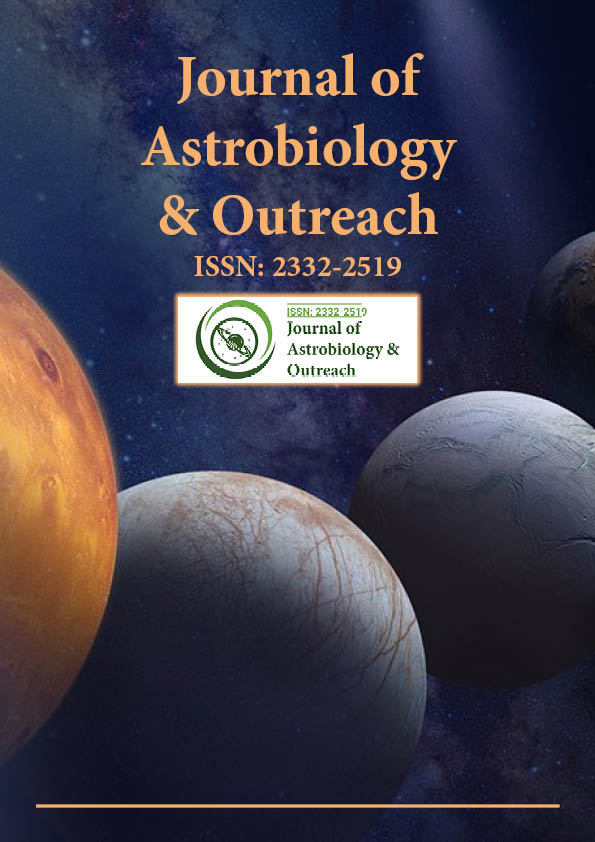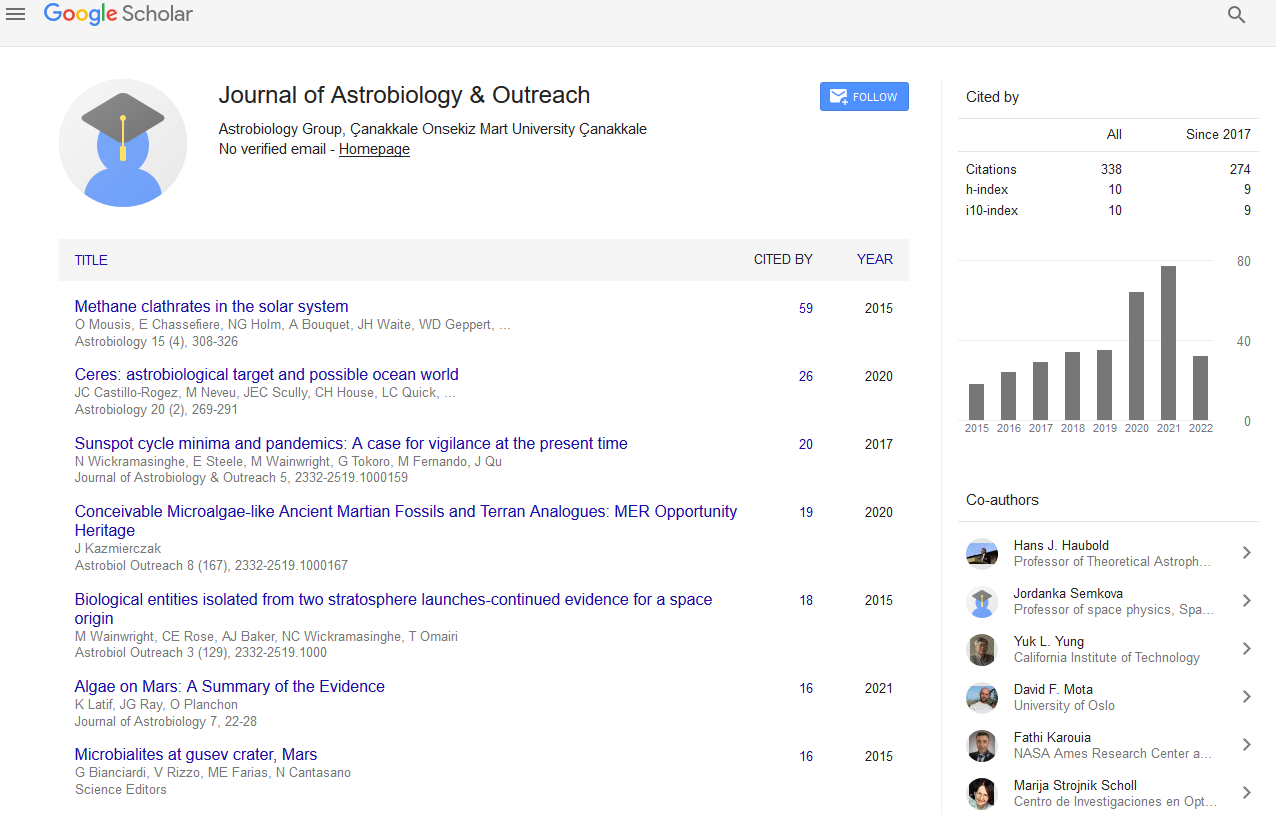Indexed In
- Open J Gate
- Academic Keys
- JournalTOCs
- RefSeek
- Hamdard University
- EBSCO A-Z
- OCLC- WorldCat
- Google Scholar
Useful Links
Share This Page
Journal Flyer

Open Access Journals
- Agri and Aquaculture
- Biochemistry
- Bioinformatics & Systems Biology
- Business & Management
- Chemistry
- Clinical Sciences
- Engineering
- Food & Nutrition
- General Science
- Genetics & Molecular Biology
- Immunology & Microbiology
- Medical Sciences
- Neuroscience & Psychology
- Nursing & Health Care
- Pharmaceutical Sciences
Commentary - (2025) Volume 13, Issue 1
Space Biology and the Architecture of Long-Duration Missions
Max Bennett*Received: 19-Feb-2025, Manuscript No. JAO-25-28777; Editor assigned: 21-Feb-2025, Pre QC No. JAO-25-28777 (PQ); Reviewed: 07-Mar-2025, QC No. JAO-25-28777; Revised: 14-Mar-2025, Manuscript No. JAO-25-28777 (R); Published: 21-Mar-2025, DOI: 10.35248/2332-2519.25.13.378
Description
In recent years, space life science has advanced at an unprecedented pace, driven by expanding human ambitions in space exploration, technological breakthroughs and an increasing understanding of the physiological, cellular and genetic changes that organisms undergo in microgravity. These developments are reforming how we envision human spaceflight, long-duration missions and even the possibility of colonizing other planets. The progress in this field is a testament to multidisciplinary collaboration, combining molecular biology, bioengineering, medicine and space technology to address fundamental questions about life beyond Earth.
One of the central challenges in space life science understands the physiological effects of microgravity on the human body. Recent findings from the NASA Twins Study, which followed astronaut Scott Kelly during his 340-day mission aboard the International Space Station (ISS), revealed important insights into immune response, gene expression, DNA methylation and cognitive function in space. Although many of the observed changes reverted after return to Earth, some persisted, suggesting long-term implications for astronaut health. These findings underscore the need for continued investigation into how prolonged space exposure influences aging, cardiovascular health and musculoskeletal degeneration.
In parallel, research on space microbiology has gained momentum. The closed environment of spacecraft makes microbial monitoring essential for crew health. Microorganisms not only adapt rapidly to space conditions but may also exhibit increased virulence or antibiotic resistance. The development of portable genetic sequencing tools like Oxford Nanopore’s MinION, successfully deployed on the ISS, has enabled in-flight microbial surveillance, representing a major step toward autonomous health management in deep space missions.
Another area of growing interest is plant biology in space. With the goal of developing sustainable life-support systems, studies have explored plant growth under artificial lighting and microgravity conditions. Experiments on the ISS and China’s Tiangong space station have demonstrated successful germination, flowering and seed production in crops such as Arabidopsis, wheat and rice. These studies not only contribute to food security during missions but also offer clues about how plants sense and respond to gravity and stress at the molecular level.
Moreover, advances in omics technologies—genomics, transcriptomics, proteomics and metabolomics—are enabling detailed profiling of biological responses to spaceflight. Initiatives like NASA’s GeneLab platform are accelerating open-access data sharing and collaborative research, promoting a global space biology community. This integrative approach is helping researchers identify biomarkers of adaptation and risk, guiding the design of countermeasures such as pharmaceuticals, tailored exercise regimens and dietary interventions.
The international landscape of space life science research is also becoming more diverse and cooperative. Countries like China, Japan, Russia and members of the European Space Agency are investing in human spaceflight programs and contributing valuable research. China’s successful deployment of the Tiangong space station has opened new avenues for experimentation, including stem cell development, tissue engineering and regenerative medicine in orbit. Collaborative missions and data-sharing agreements are essential for maximizing the utility of these efforts and avoiding redundancy.
Artificial Intelligence (AI) and machine learning are also playing increasingly important roles in managing and interpreting complex space biology data. Predictive models are being developed to simulate human physiological responses under different mission scenarios, aiding in decision-making and mission planning. AI-powered diagnostics and personalized medicine could be essential tools for future crew autonomy on missions far from Earth.
Importantly, space life science is no longer limited to astronaut safety but is contributing to broader scientific and medical knowledge. Studies conducted in space often model extreme conditions or accelerate biological processes, providing unique insights into diseases such as osteoporosis, immune disorders and neurodegeneration. The translational value of this research is becoming increasingly apparent, providing innovations that benefit healthcare on Earth.
In conclusion, recent progress in space life science research highlights both the remarkable strides made and the challenges that lie ahead. As humanity pushes further into the cosmos, it becomes ever more critical to understand how living systems function and adapt beyond our home planet. Continued global collaboration, investment in research infrastructure and integration of emerging technologies will be main factor to unlocking the full potential of this exciting frontier. The path forwards not only assures safer, longer and more sustainable missions but also holds significant implications for biology, medicine and our place in the universe.
Citation: Bennett M (2025). Space Biology and the Architecture of Long-Duration Missions. J Astrobiol Outreach. 13:378.
Copyright: © 2025 Bennett M. This is an open-access article distributed under the terms of the Creative Commons Attribution License, which permits unrestricted use, distribution, and reproduction in any medium, provided the original author and source are credited.

